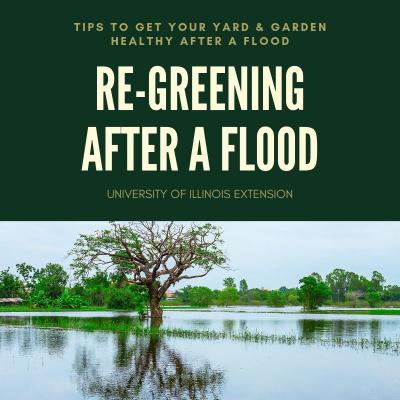FOR IMMEDIATE RELEASE
Floods can devastate your home and property, including your lawn and garden. A flooded yard is a frightening and messy experience. In just a few minutes, your carefully planted garden can be washed away by heavy flood waters or be submerged for an extended length of time. Martha Smith, horticulture educator with University of Illinois Extension researched ways you can recover your yard and landscape after a flood, whether it’s severe devastation or minor flooding. A flood is defined by FEMA as a condition of partial or complete inundation of normally dry land areas from the overflow of inland or tidal waters or the rapid accumulation of waters from any source. There are three main types of floods: coastal, riverine and shallow. Along the Mississippi in 2019, riverine floods came about after heavy rainfall over an extended period of time, which caused nearby rivers to overflow and engulf surrounding towns. Shallow floods are also caused by excess rainfall, but they are not dependent on a body of water nearby. This kind of flooding most commonly occurs in urban areas.
Note: Always be sure to follow the safety protocols outlined by your local government. Contact FEMA or your nearest disaster recovery center if your home has experienced significant damage.
Immediately After a Flood
- Whenever you can help it, don't walk on your wet soil. When soil is soft and soggy, it will compress more easily with any amount of pressure. This could ultimately cause damage to the roots of your plants. Besides what's necessary for the initial cleaning, don't walk on your wet soil if you can help it.
- Let the waters subside naturally. If needed, use buckets to drain any lingering, stagnant water in your yard.
- Rinse your plants, shrubs and bushes to remove residues left over by contaminated water. You’ll also want to clear off any mud and debris to prevent disease. The leaves, stems and all exposed areas should be rinsed thoroughly.
- Clear the mulch from plants, shrubs and bushes. The goal is to encourage evaporation, and mulch will prevent the excess moisture from escaping. Avoid tilling the soil at this time.
- Aerate. It may take weeks for your yard to dry out, but new growth will appear. When dry, aerate your yard and garden beds with a garden fork or a lawn aerator to help the drying process.
- Clean up fallen leaves, branches and debris in the yard.
- Throw away all fruits, vegetables and herbs that were submerged by the flood water. They are no longer safe for consumption.
Tip: Watch out for contamination. Water from nearby plants and sewers can sometimes runoff into residential areas during a flood. Before the water in your yard completely subsides, take a look at the surface and look out for an oily sheen or an abnormally foul smell. Consult a professional for a soil test to identify and remove any hazardous contaminants.
Continued Recovery
- Use care when cleaning up and treating your yard. Wear gloves, boots, and appropriate protection for yourself, and wash your hands with antibacterial soap after you've been doing yard work.
- A few days after the flood waters recede, remove any pools of standing water to prevent mosquitoes from breeding in your yard or garden.
- Prune plants and shrubs, and remove the dead foliage to help foster new growth.
- Replace the soil in potted plants to encourage a speedy recovery.
- Replant any edibles that were removed immediately after the flood.
- Get rid of compost that was submerged in contaminated water. Compost submerged in fresh water can still be used.
- Avoid applying fertilizer at this time. Instead, water your entire lawn and garden to remove lingering silt and sediment. Then, apply fresh pesticide to combat bugs and fungal diseases.
- After the lawn has dried, lightly mow the grass and let it grow a bit taller than usual before resuming your regular mowing schedule. If the flood occurs during the cooler months, wait until the temperatures rise before mowing.
- Inspect and flush your sprinkler system. Irrigation lines can get clogged with flood debris, so make sure your system is still in working order.
- Be patient. The recovery process will take time, but your landscape will bounce back with the right maintenance and care.
What next?
There are many factors that can affect a plants’ long and short-term health. The primary limiting factor is inadequate oxygen exchange in saturated soils. The roots of all plants need access to oxygen in the soil. When soils are saturated, an anaerobic environment is created where plant roots are not getting proper oxygenation. There are not many options to help perennial plants except to watch for signs of stress after the event. Symptoms can include yellowing or browning of leaves, leaf curling or wilting, reduced new leaf size, complete defoliation or branch/stem die-back. Plants that are fully submerged for extended periods may rapidly decline. Mostly with trees, we may see cases that include gradual plant decline and death over several years. There is good news - many plants can tolerate 7-10 days of flooding. “Wait and see” is the best advice
For further questions Call 309-756-9978 University of Illinois Extension’s Horticulture Hotline, from 9 am – noon, Tuesday, Wednesday and Thursdays located at their office in Milan, IL.
Local source: Martha Smith, Horticulture Educator (309) 756-9978 smithma@illinois.edu
Sources for these tips: Texas A&M Agrilife Extension, https://www.doityourself.com/stry/how-to-revive-a-flooded-yard, Landscape and Garden Tips: How to Recover after a Flood, Home Depot
Source: Martha A. Smith, Extension Educator, Horticulture, smithma@illinois.edu
Pull date: June 30, 2019
